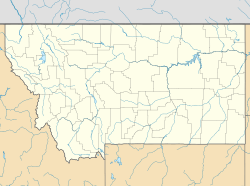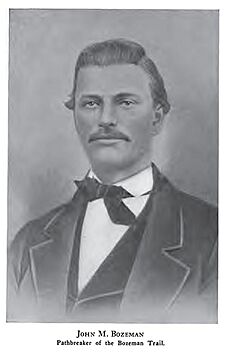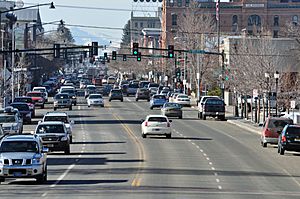Bozeman, Montana facts for kids
Quick facts for kids
Bozeman
|
|||
|---|---|---|---|
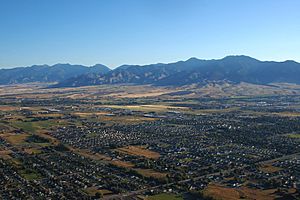
Aerial view of Bozeman
|
|||
|
|||
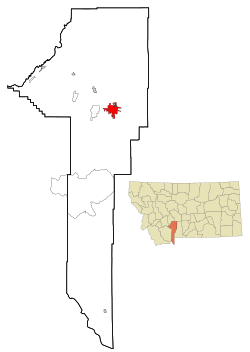
Location of Bozeman, Montana
|
|||
| Country | United States | ||
| State | Montana | ||
| County | Gallatin | ||
| Founded | August 9, 1864 | ||
| Named for | John Bozeman | ||
| Government | |||
| • Type | City commission/City manager | ||
| Area | |||
| • City | 20.91 sq mi (54.16 km2) | ||
| • Land | 20.86 sq mi (54.04 km2) | ||
| • Water | 0.05 sq mi (0.13 km2) | ||
| Elevation | 4,817 ft (1,468 m) | ||
| Population
(2020)
|
|||
| • City | 53,293 | ||
| • Estimate
(2022)
|
56,123 | ||
| • Density | 2,554.43/sq mi (986.26/km2) | ||
| • Metro | 118,960 | ||
| • Demonym | Bozemanite | ||
| Time zone | UTC−7 (MST) | ||
| • Summer (DST) | UTC−6 (MDT) | ||
| ZIP codes |
59715, 59717-59719, 59718, 59771-59772
|
||
| Area code(s) | 406 | ||
| FIPS code | 30-08950 | ||
| GNIS feature ID | 0769173 | ||
| Website | www.bozeman.net | ||
Bozeman is a city in Montana, United States. It is the main city of Gallatin County, Montana. In 2020, about 53,293 people lived in Bozeman. This makes it the fourth-largest city in Montana.
Bozeman is also the main city in the Bozeman, Montana, Micropolitan Statistical Area. This area includes all of Gallatin County and has about 118,960 people. It has been one of the fastest-growing areas in the U.S.
Contents
Bozeman's Past: A Look at History
Who Lived Here First?
For many years, different Native American tribes traveled through the area where Bozeman is now. These tribes included the Shoshone, Nez Perce, Blackfeet, Flathead, Crow Nation, and Sioux. They called this beautiful area the "Valley of the Flowers." The Gallatin Valley, where Bozeman is located, was mainly part of the Crow people's land.
How Did Bozeman Begin?
In July 1806, William Clark, a famous explorer, visited this area. He was traveling east from Three Forks along the Gallatin River. His group camped a few miles east of where Bozeman is today.
Meet John Bozeman
In 1863, a pioneer named John Bozeman opened a new path called the Bozeman Trail. This trail branched off the Oregon Trail and led to the mining town of Virginia City. It went right through the Gallatin Valley, where Bozeman would later be built.
John Bozeman, along with Daniel Rouse and William Beall, planned the town in August 1864. He wanted it to be a key spot for people coming to the territory from the east. The Bozeman Trail was closed in 1868 due to conflicts with Native American tribes, but the rich land still attracted many settlers.
Nelson Story's Cattle Drive
In 1866, Nelson Story, a successful gold miner, decided to start a cattle business. He bravely led about 1,000 longhorn cattle through the challenging Bozeman Trail. He brought them to Paradise Valley, Montana, just east of Bozeman. Story managed to avoid the U.S. Army, who wanted him to turn back to protect his cattle from hostile tribes. His cattle became one of the first big herds in Montana's cattle industry. Nelson Story later gave land to the state to help start Montana State University.
Fort Ellis: A Protective Outpost
Fort Ellis was built in 1867 to help protect settlers and miners in the area. It was named after Colonel Augustus Van Horne Ellis. The fort was closed in 1886, and today, not much is left of the original site. It is now part of the Fort Ellis Experimental Station of Montana State University. Another short-lived fort, Fort Elizabeth Meagher, was also built in 1867 by volunteer soldiers about 8 miles (13 km) east of town.
Bozeman in the Late 1800s
In 1864, W.W. Alderson called Gallatin County "one of the most beautiful valleys the eye ever beheld." Many people agreed, and Bozeman soon earned the nickname "The Egypt" of Montana because of its fertile land.
The first newspaper in Bozeman, the Avant Courier, was published on September 13, 1871. It is now known as the Bozeman Chronicle.
Bozeman's main cemetery, Sunset Hills Cemetery, was given to the city in 1872. This happened after William Henry Blackmore bought the land when his wife passed away in Bozeman.
The city's first library opened in 1872. It started in a room above a drugstore and later moved to the mayor's office. The city took it over in 1890.
The Northern Pacific Railway reached Bozeman in 1883, connecting the city to the east. By 1900, Bozeman's population had grown to 3,500 people.
In 1892, a fish hatchery was built on Bridger Creek. This was the fourth oldest fish hatchery in the United States. Today, it is the U.S. Fish and Wildlife Service's Bozeman National Fish Hatchery. It is now a center for fish technology and health. About 5,000 visitors come each year to see biologists working on fish diets, diseases, and water quality.
Bozeman also had early minor league baseball teams. In 1892, a Bozeman team played in the Montana State League. In 1909, the Bozeman Irrigators played in the Inter-Mountain League.
Montana State University was founded in 1893. It was first called the Agricultural College of the State of Montana. By the 1920s, it was known as Montana State College. In 1965, it officially became Montana State University.
Bozeman in the 1900s
Bozeman's first high school, Gallatin Valley High School, was built in 1902. It is now called Willson School and is used for the Bozeman School District's offices.
In the early 1900s, farmers in the Gallatin Valley grew a lot of edible peas. Bozeman became a major producer of canned peas. At one point, it produced about 75% of all seed peas in the U.S. The area was even called the "Sweet Pea capital of the nation." To celebrate, local businesses started a "Sweet Pea Carnival" from 1906 to 1916. It had a parade and a queen contest. The celebration used the colorful sweet pea flower as its symbol. In 1977, the "Sweet Pea" idea was brought back as an arts festival. It is now a big three-day event in Montana.
The first federal building and Post Office was built in 1915. This building was later used as a filming location for the movie A River Runs Through It (1992). Today, it is used by the HRDC, a community group.
The Bridger Bowl Ski Area opened in 1955. It was Bozeman's first ski area. In 1973, news anchorman Chet Huntley helped create the Big Sky Ski Resort, about 40 miles (64 km) south of Bozeman. This resort has grown a lot and is now a major winter tourist spot.
The Museum of the Rockies was created in 1957. It is part of Montana State University and is connected to the Smithsonian. It is Montana's top museum for natural and cultural history. It has exhibits on dinosaurs, geology, and Montana history. It also has a planetarium and a living history farm. Famous paleontologist Jack Horner was the museum's first dinosaur expert. He made the museum famous with his fossil discoveries in the 1980s.
Bozeman attracts many new residents and visitors because of its fun outdoor activities. These include fly fishing, hiking, whitewater kayaking, and mountain climbing. Bozeman is also a gateway city for people visiting Yellowstone National Park. Movies like A River Runs Through It and The Horse Whisperer have also shown off the area's beautiful scenery.
Bozeman Today: The 21st Century
Bozeman has grown a lot since the 1980s. It is now the fourth-largest city in Montana. Many people move here because of the great quality of life, beautiful scenery, and nearby outdoor fun. In 2010, Outside magazine even called Bozeman the best place to live in the west for skiing.
Because of the growth in the Gallatin Valley, the Gallatin Field Airport was expanded in 2009. It added new gates and a bigger passenger area. Later, Gallatin Field was renamed Bozeman Yellowstone International Airport.
Bozeman has been one of Montana's fastest-growing cities since 1990. It is still growing at a steady rate. If this continues, Bozeman could soon become Montana's third-largest city.
Where is Bozeman? Geography and Climate
Bozeman is located at an elevation of about 4,820 feet (1,469 meters) above sea level. It is surrounded by mountains. To the north are the Bridger Mountains. To the west are the Tobacco Root Mountains. The Gallatin Range is to the south, and the Spanish Peaks are to the south-southwest.
Bozeman is east of the continental divide. Interstate 90 goes through the city. It is about 84 miles (135 km) east of Butte and 93 miles (150 km) north of Yellowstone National Park.
The city covers about 19.15 square miles (49.60 square kilometers). Most of this is land, with a small amount of water.
Bozeman has a humid continental climate. This means it gets more rain than many other parts of Montana. It can receive up to 24 inches (610 mm) of rain each year. This helps plants grow very well. This is why the Gallatin Valley was once called the "Valley of the Flowers."
Bozeman has cold, snowy winters and warm summers. However, because it is high up, temperatures can change a lot between day and night. The hottest temperature ever recorded in Bozeman was 105°F (41°C) on July 31, 1892. The coldest was -46°F (-43°C) in 1957 and 1983.
Who Lives in Bozeman? Demographics
| Historical population | |||
|---|---|---|---|
| Census | Pop. | %± | |
| 1870 | 168 | — | |
| 1880 | 894 | 432.1% | |
| 1890 | 2,143 | 139.7% | |
| 1900 | 3,419 | 59.5% | |
| 1910 | 5,187 | 51.7% | |
| 1920 | 6,183 | 19.2% | |
| 1930 | 6,855 | 10.9% | |
| 1940 | 8,665 | 26.4% | |
| 1950 | 11,325 | 30.7% | |
| 1960 | 13,361 | 18.0% | |
| 1970 | 18,670 | 39.7% | |
| 1980 | 21,645 | 15.9% | |
| 1990 | 22,660 | 4.7% | |
| 2000 | 27,509 | 21.4% | |
| 2010 | 37,280 | 35.5% | |
| 2020 | 53,293 | 43.0% | |
| 2022 (est.) | 56,123 | 50.5% | |
| source: U.S. Decennial Census |
|||
Bozeman's Population in 2020
In 2020, Bozeman had 53,293 people and 22,041 households. The city's population density was about 2,587 people per square mile (999 people per square kilometer). This was a big increase from 2010.
Most people in Bozeman are White (88.6%). About 4.8% are Hispanic or Latino, 2.4% are Asian, and 1.1% are American Indian. About 5.6% of residents said they were two or more races.
The average household in Bozeman has 2.24 people.
About 13.2% of Bozeman's population is under 18 years old. About 10.7% are over 65 years old. Most adults (97.8%) have finished high school or higher education. Many (64.2%) have at least a bachelor's degree. The city has slightly more males (53%) than females (47%).
The average household income in Bozeman was $74,113. About 14.7% of the population lived below the poverty line.
Learning in Bozeman: Schools and University
Public Schools
Bozeman Public Schools has two parts: the Elementary School District and the High School District. Most of Bozeman is in these districts.
- The Bozeman Public School District has two high schools: Bozeman High School and Gallatin High School.
- It also has two middle schools: Chief Joseph Middle School and Sacajawea Middle School.
- There are eight elementary schools: Emily Dickinson, Hawthorne, Hyalite, Irving, Longfellow, Meadowlark, Morning Star, and Whittier.
- The district also runs the Bridger Alternative Program for students who need a different learning environment.
Private Schools
- Mount Ellis Academy is a private high school (grades 9-12) connected to the Seventh-day Adventist Church.
- Headwaters Academy is a private middle school (grades 6-8) near Montana State University.
- Petra Academy is a private school (pre-kindergarten through 12th grade) with Protestant teachings.
Higher Education
- Bozeman is home to Montana State University. It is the largest university in Montana. In fall 2018, it had 16,902 students.
Getting Around: Transportation in Bozeman
Bozeman is located along Interstate 90, which runs east-west. U.S. Highway 191 goes south from Bozeman to Big Sky and West Yellowstone.
Bozeman has a free public bus system called Streamline. It started in 2006. Streamline has six routes that cover the university, shopping areas, downtown, and even service to Belgrade and Livingston (at certain times of the year).
The Bozeman Yellowstone International Airport is west of Bozeman. It serves travelers going to Bozeman, Big Sky, West Yellowstone, and Yellowstone National Park.
Famous People from Bozeman
Many interesting people have lived in Bozeman or have strong ties to the area.
- Sports Stars
- Conrad Anker, a famous mountaineer.
- Will Dissly, a tight end for the Seattle Seahawks.
- Jeff Fisher, a former NFL football coach.
- Alex Lowe, a well-known ice-climber.
- Jan Stenerud, a football player in the Pro Football Hall of Fame.
- Pioneers and Historical Figures
- John Bozeman, the pioneer who founded the Bozeman Trail.
- Nelson Story, an important cattleman in Bozeman's early days.
- Artists, Writers, and Entertainers
- Brannon Braga, a writer and producer for Star Trek TV shows.
- Gary Cooper, a famous film actor who went to high school in Bozeman.
- Jason Lytle, the lead singer of the band Grandaddy.
- Ben Mikaelsen, an author.
- Robert Redford, the director of the movie A River Runs Through It, filmed in Bozeman.
- Sarah Vowell, an author and voice actress.
- Scientists and Thinkers
- Loren Acton, an astronaut and physicist.
- Jack Horner, a leading dinosaur expert. The main character in the Jurassic Park book and movie was based on him.
- Robert M. Pirsig, an author who taught English at Montana State University.
What Can You Do in Bozeman? Points of Interest
Bozeman has many cool places to visit and things to do!
- Museums and Gardens
- American Computer Museum: Learn about computers and technology.
- Gallatin Historical Society-The Pioneer Museum: Discover Bozeman's past.
- Montana Arboretum and Gardens: Explore beautiful plants and nature.
- Museum of the Rockies: See dinosaur exhibits, learn about Montana history, and visit a planetarium.
- Libraries
- Bozeman Public Library: A great place to find books and learn.
- Renne Library: The main library at Montana State University.
- Ski Areas
- Bridger Bowl Ski Area: Hit the slopes for skiing and snowboarding.
- Universities
- Montana State University: A large university with many students.
- Other Fun Spots
- East Gallatin Recreation Area: Enjoy outdoor activities.
- Hyalite Canyon and Reservoir: A beautiful area for hiking and enjoying nature.
- Sweet Pea-A Festival of the Arts: A big arts festival held every year.
- U.S. Fish and Wildlife Service Fish Technology Center: See how scientists work with fish.
Images for kids
See also
 In Spanish: Bozeman para niños
In Spanish: Bozeman para niños




